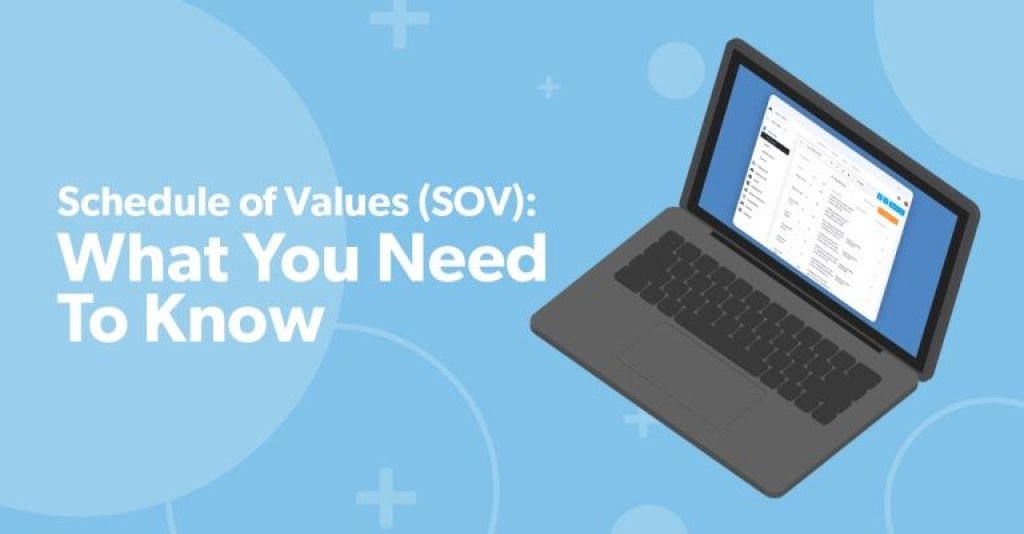A schedule of values clearly demonstrates all the work and resources applied to a construction project. Learn how to create a schedule of values and use this type of documentation to better support your business.
What is a schedule of values (SOV)?
A schedule of values—or SOV—is a document that lists all work associated with a construction project, including the costs. Contractors use SOVs to help manage project budgets and accurately track performance.
Why is a schedule of values important?
A schedule of values is important because it’s an itemized breakdown of a construction company’s investment in a project’s success. It is documented proof of cost and effort.
In construction, an SOV supports financial initiatives, like billing and payroll, and can be used as a reference in the event of a dispute or litigation.
When is a schedule of values used?
A schedule of values is most often created for large and complex construction projects. When there are many moving pieces involved in a project, an SOV helps contractors closely monitor spending and manage resources.
The Construtor explains, a schedule of values is frequently used by “general contractors, subcontractors, property owners, and construction managers”. The project manager or another stakeholder with visibility of the entire project will likely create and maintain the SOV.
Subcontractors may be required to provide a separate subcontractor SOV when working with GCs.
Schedule of values best practices
Now that you understand the meaning of an SOV in construction, it’s time to put one together. How do you make a schedule of values? While your exact process may vary based on the services you offer, there are several best practices for creating an SOV to keep in mind.
Determine the need for an SOV
Putting together a schedule of values for a construction project can be a time-intensive process. While every project can benefit from having one, it’s not always a necessity.
As yourself the following questions:
Is this a large or complex construction project?
Are there several different moving pieces involved?
Are you managing a large number of subcontractors?
Is this a risky project?
Will having an SOV help facilitate communications with the project owner or other stakeholders?
If you can answer yes to any of these questions, it’s a good idea to create an SOV.
Use a template as a base
If you’ve never created a schedule of values, a template can give you a great head start.
The SOV structure is extremely important. You need to include all relevant information but keep it as clear and concise as possible.
Remember to include:
A description of each task and work item
Each task or work item’s associated cost
The percentage of task or work item completion
Current spending vs. project budgets
These are the basic details most construction SOVs should cover, but you can always include more information in your document.
Because of the level of detail and the calculations that must be included, most SOV templates use a spreadsheet format.
Closely monitor project progress
To be most beneficial, an SOV must be informed by project progress. Without a close eye on what’s happening in the field each day, your schedule of values isn’t going to be very helpful or accurate.
Focus on improving your daily reporting and production tracking processes to help you create an SOV that’s useful and effective.
Analyze performance periodically
A schedule of values is a constantly evolving document. It will grow as the project progresses.
Use the data you’re collecting to periodically analyze how productivity is measuring up to the project budget. The SOV should serve as evidence when you need to adjust a schedule or revisit contract terms.
Be accurate
It can be tempting to inflate or deflate costs as needed when listing items on an SOV. But it’s crucial you avoid this temptation.
A schedule of values isn’t supposed to make your team look good. Its purpose is to better inform your business decisions. When the SOV accurately reflects performance, you can use that information to adjust schedules or budgets efficiently and reduce miscommunications with your customers.
How Raken helps with SOVs
Our construction management app helps busy construction businesses closely monitor the jobsite. Our digital daily reporting tools make capturing detailed field data easy, while our automated production insights give project managers a clear view of what’s happening onsite without hours of collecting and analyzing information.
Track time and materials and manage your project budget efficiently with Raken. Then, use this better visibility to keep work on track and create an SOV that paints an accurate picture of progress.
